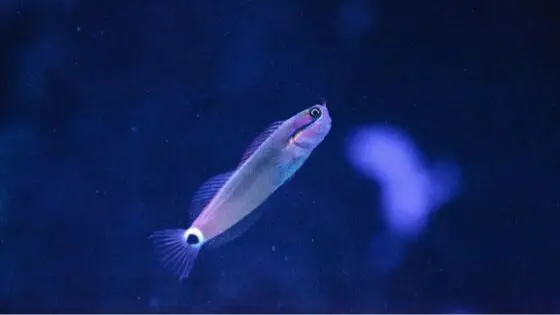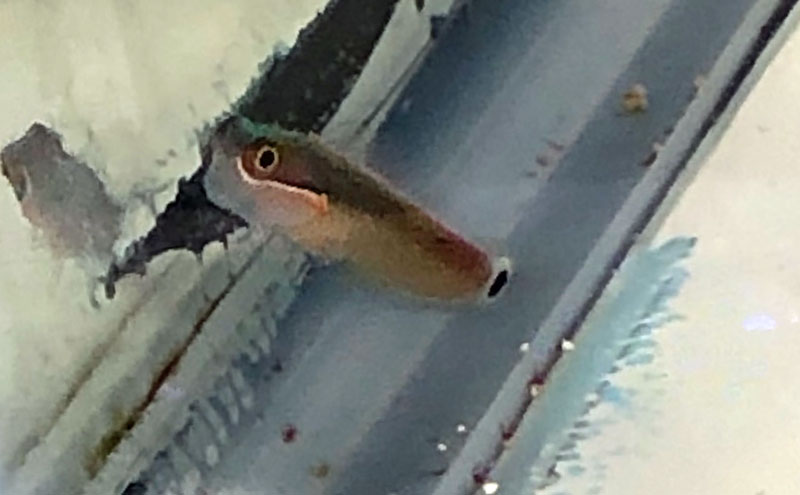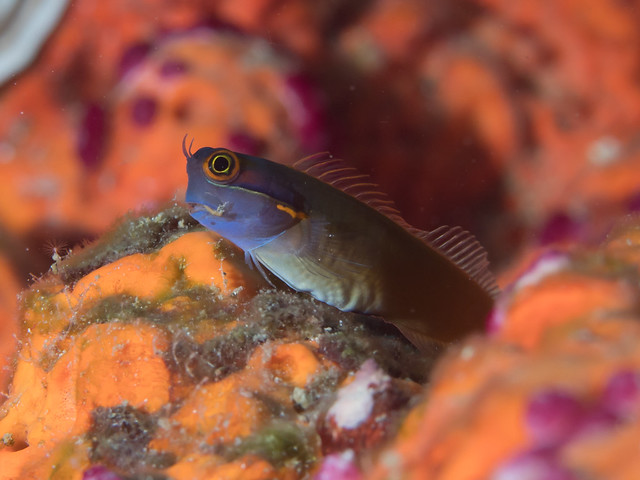Looking to learn more about a hardy, inexpensive smaller fish that gets along well with other reef fish and packs a ton of personality? Then you’re in the right place…I mean…spot. Whether you have a giant reef tank or a nano aquarium, you should seriously consider the Tailspot blenny.
Table of contents
If you are looking for something specific, you can use the Table of Contents below to jump right to that section.
Quick Facts About the Tailspot Blenny:
- Scientific Name: Ecsenius stigmatura
- Common Names: Tailspot Coral Blenny
- Max Size: 2.5 Inches
- Minimum Tank Size: 8 gallons
- Aggression Level: Docile
- Color: Blue, Yellow, Orange, Green, Black, White, Brown
- Care Level: Beginner
- Most Active: Day
- Lifespan: 3 to 5 Years
Natural habitat
Like many of the other reef fish commonly available in the aquarium hobby, the Tailspot blenny originates from the Indian and Pacific Oceans. This species can commonly be seen in the reef areas bordering countries like Indonesia and the Philippines in reefs where it can quickly retreat into corals or between rocks for protection, and pop out to snag bits of food that float by.
Proper Tank Conditions
Since the Tailspot blenny will generally only grow to a maximum size of about 2.5 inches, they are a great option for just about any-sized tank, whether it is a pico, nano, or full-sized reef tank. If you want to house multiples blennies in the same aquarium, it is probably best to consider a tank about 20-gallons or larger—although I’m sure you could manage a bonded pair in a smaller tank (10-gallon minimum, assuming the pair was well behaved and wasn’t showing aggression.
Also like most other reef fishes, they would do best in a tank with live rock (and/or corals) that allows plenty of places to perch and hide.

They don’t have any specific water requirements beyond the standard reef aquarium water parameters:
- Temperature: ~78-82 degrees Fahrenheit
- pH: 7.8-8.2 (pH doesn’t have any specific units)
- Specific gravity: 1.025 (to match ideal reef parameters, although you could go lower if it was a fish-only system)
- Ammonia, and nitrites as close to 0 as possible
- Phosphates, nitrates, and silicates, perhaps controversially—you might want to have low, stable, but higher than zero—I’ll explain more about that, in a bit.
You achieve water parameters like this by mixing RO/DI water with a high-quality salt mix, like Instant Ocean.

If you are new to the hobby, learn more about:
In general, you want your reef tank to have very low (non-detectable) levels of phosphates and silicates—because phosphates and silicates act as fertilizers that grow problem algae.
However, your Tailspot blenny would benefit from grazing on some hair algae, which is why I am sort of signaling that having a little bit of phosphate/silicate might be good or at least, not the end of the world.
Of course, this could be a slippery slope. You certainly don’t want levels of those pollutants to get too high and you want to make sure the algae doesn’t get out of control—but a little bit of algae in the tank would serve as a nutritious, healthy, natural food source.

Of course, another way to ensure adequate nutrition would be to provide some food options (like Spirulina flakes) that will provide them with the plant-based nutrition they need.
You can use any type of substrate, although a sandy substrate is preferable with the Tailspot Blenny, and the species do prefer to have a calmer flow of water in their environment.
The last requirements are to make sure you don’t keep them in a tank with something that will eat them and that your aquarium has is a tight-fitting lid. These little fellas are jumpers and have been known to carpet-surf to their death.
Behavior
The Tailspot Blenny prefers to spend most of its time towards the lower-portion of the tank, perched on the substrate floor or on live rock or corals, darting in and out of crevices.
If your tank does have green hair algae…BOOO—-I mean—yeah—you will hopefully see them out grazing, helping turn that problem algae into a burst of blenny energy. with ample hair algae to eat, you will find them hanging out and grazing on the algae-covered substrate.
Buyer beware that a hungry blenny may start to nip at fleshy coral polyps. Since they are small fish, even a rogue polyp-nipper probably won’t cause too much damage, if the corals are relatively well-established in your tank (and not new frags).
The Tailspot Blenny is hardy and can live for several years with proper care. New owners should be warned as this species likes to act out when first introduced to a tank. They do sometimes play dead, when threatened, so don’t get too alarmed, and certainly don’t be too hasty with the net. If your otherwise healthy fish looks dead one day, check back in a few hours, just to be sure.
Compatibility
Ecsenius stigmatura is a peaceful species that is compatible with most community reef fishes and corals that won’t treat it as a food source/fish stick. They can be added to an established community with little to no problems and are best suited to tanks with other peaceful, non-aggressive species. But then again, that advice is good generally for any community tank.
But don’t forget that the tiny Tailspot blenny only reaches a maximum size of 2.5 inches, which is the perfect fish stick size for some reef fishes with big mouths.
This species, like most reef aquarium fish, does exhibit some aggression towards the same species or even other similar/related blenny species. So it’s best to keep one blenny per tank, for the most part.
Here are a few great community fish you could consider:
Reproduction & Sexing
The Tailspot Blenny has been successfully bred in captivity. Males and females can be difficult to tell apart (they lack an easily recognizable sexual dimorphism), which could make pairing them up a bit tricky.
For reasonable odds of establishing a pair, you might have to purchase 5 or 6 individuals. Of course, if that’s your goal, you will need a backup plan for the remaining 3-4 fish.
Once the breeding process has started the female Tailspot Blenny places eggs on the walls of the cave over the course of a few days. Each time, after she is done placing the eggs, the male will enter the cave to fertilize them.
The male will begin to guard the cave at this point to keep his offspring safe. The larvae should hatch within one to three days.
Raising newly hatched saltwater fish is a lot harder than raising freshwater fry. They require tiny live foods and undergo a metamorphosis.
I’ve personally never successfully bred the tailspin blenny, but I have had success with the neon goby, which is an even smaller cave-spawner.
Feeding
Ecsenius stigmatura is a herbivore who loves to search the tank for food. They can help clear up an algae problem—it’s literally what they’re born to do. If there are no algae in your tank, then you will need to feed them with algae-based flakes or disks.
This is a mighty little fish with a big metabolism and does best when fed multiple small meals each day. If you see your Tailspot blenny nipping at coral polyps, chances are good that it is hungry…and likely underfed. That’s a sign to step up the feeding.

Tailspot blenny for sale
Looking to find a Tailspot blenny for sale? The good news is that it shouldn’t be difficult. This is a popular and commonly available saltwater fish species that will cost you around $25 online and at local fish stores. Good news too that the fish handles the shipping and handling relatively well too.
Whether to Buy a Tailspot Blenny or Not
Their small size makes the Tailspot blenny appropriate for all but the absolutely smallest pico aquariums.
If you have a problem with problem algae, this colorful and charismatic little fish can help you out and add some depth to your aquarium. But this could be an excellent addition to your tank even if you don’t have an algae problem—as long as you’re able to get it to eat prepared veggie-based foods.
As long as you’re willing to make sure to meet the nutritional requirements of this fish, problem algae or not, there’s a pretty good chance you can have success with this fish.

More information
Want to learn about other ways to deal with aquarium algae? Check out these articles:
Looking for other amazing saltwater fish perfect for a nano aquarium?
Want to dive deeper into the Tailspot blenny, learn more by watching this video:
References
Michael, Scott W. Marine Fishes: 500+ Essential-to-Know Aquarium Species. TFH Publications. Neptune City, NJ: 2001.



Leave a Reply